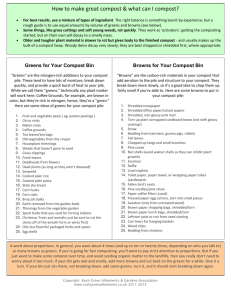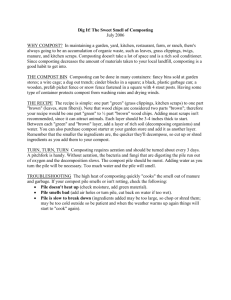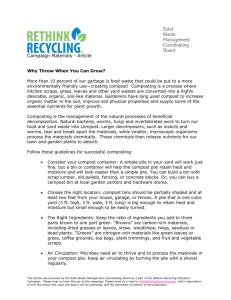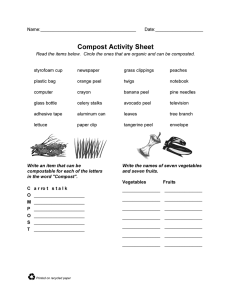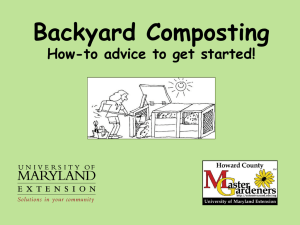Backyard composting do`s and don`ts
advertisement
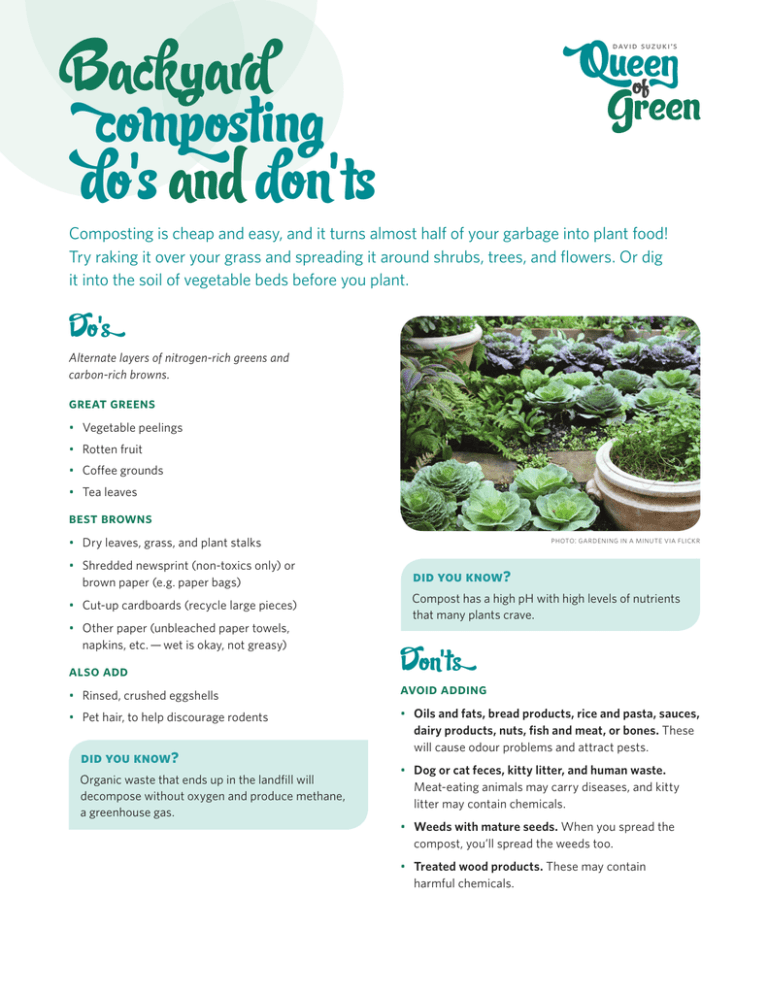
Backyard composting do's and don'ts dav i d suzu k i ’ s Composting is cheap and easy, and it turns almost half of your garbage into plant food! Try raking it over your grass and spreading it around shrubs, trees, and flowers. Or dig it into the soil of vegetable beds before you plant. Do's Alternate layers of nitrogen-rich greens and carbon-rich browns. great greens • Vegetable peelings • Rotten fruit • Coffee grounds • Tea leaves best browns • Dry leaves, grass, and plant stalks • Shredded newsprint (non-toxics only) or brown paper (e.g. paper bags) • Cut-up cardboards (recycle large pieces) • Other paper (unbleached paper towels, napkins, etc. — wet is okay, not greasy) also add • Rinsed, crushed eggshells • Pet hair, to help discourage rodents did you know? Organic waste that ends up in the landfill will decompose without oxygen and produce methane, a greenhouse gas. photo: gardening in a minute via flickr did you know? Compost has a high pH with high levels of nutrients that many plants crave. Don'ts avoid adding • Oils and fats, bread products, rice and pasta, sauces, dairy products, nuts, fish and meat, or bones. These will cause odour problems and attract pests. • Dog or cat feces, kitty litter, and human waste. Meat-eating animals may carry diseases, and kitty litter may contain chemicals. • Weeds with mature seeds. When you spread the compost, you’ll spread the weeds too. • Treated wood products. These may contain harmful chemicals. Troubleshooting compost pile is wet and stinky • Problem: Too many greens • Solution: Add browns, turn pile, and put scraps in the centre of the pile. pile is dry • Problem: Too many browns and not enough water photo: looseends via flickr Tips • Solution: Add fresh kitchen scraps. Moisten the pile with water and cover to reduce evaporation. pile is cold in the kitchen • Problem: Lack of nitrogen • Cut food scraps into smaller pieces for faster decomposition. • A glass or metal container for collecting kitchen waste won’t hang onto odours the way plastics do. A tightfitting lid will keep the fruit flies out. • If the fruit flies bother you, store food scraps in the fridge or freezer. outside • Select a level, partially shaded spot with good water drainage for your bin. Place it 20 to 30 cm away from walls, fences, bushes, doors, and windows. • Whenever you add a food layer (green or eggshells), top it with browns. • The beneficial microorganisms in your compost pile need oxygen. Leave lots of air space in your bin, and mix the contents every week or two. • Collect dry leaves and grass in a separate, dry container. Then you can add them year-round. • Compost is generally ready to use after a few months. • Don’t be alarmed if your pile steams or stinks — that means materials are decomposing. • If you’re making your own bin, the idea size is about one cubic metre. | • Solution: Add greens. compost is attracting pests (rodents, raccoons, etc.) • Problem: Improper materials added, and insufficient coverage • Solution: Use a pest-resistant bin. Avoid adding grease, oils, meats, and breads. compost is attracting fruit flies • Problem: Food scraps are exposed • Solution: Put kitchen scraps in centre of pile and cover greens with browns. did you know? Compost contributes more nutrients to your yard and garden than sterilized peat moss. | photo: thierry marysael via flickr For more information, go to queenofgreen.ca photo: aidan grey via flickr
